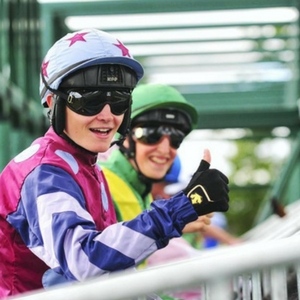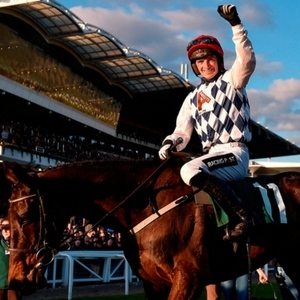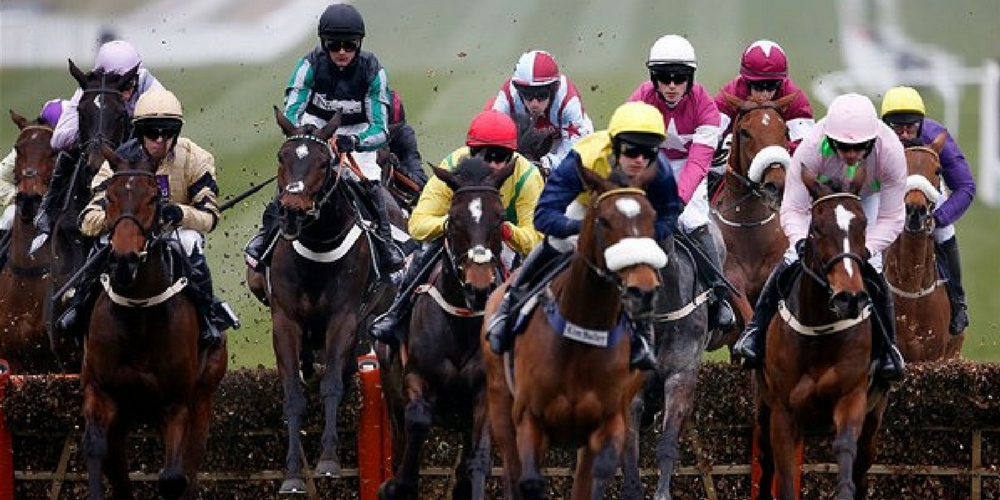How jockeys are training and using Sports Science and Strength & Conditioning as part of their physical preparation.
One would be forgiven for thinking, in this ‘Championship’ week of horse racing at Cheltenham, that the jockeys just spend their days riding horses and losing weight. However, the trust in physical preparation and sports science amongst licensed jockeys is changing and all for the better.

Denis Linehan & Ross Coakley. Photo credit: Healy Racing
In my role as official S&C Coach with the Jockey Pathway, I see these jockeys 4-5 days per week. I am part of a team of professionals including a Registered Dietician, an IIS accredited Sports and Exercise Psychologist and a Chartered Physiotherapist. We provide these services to all licensed jockeys. There is a fantastic joined-up approach and I am regularly in touch with the other members of the team.
Jockeys have always had one common goal and that is making weight. For most flat jockeys they would probably want to weigh in at somewhere between 50-58kg and National Hunt (jumps) jockeys between 60-65kg. Historically jockeys would avoid the gym for fear of gaining weight. Today many jockeys will visit the gym 4-5 days per week. They are also improving their relationship with food and Gillian O Loughlin our Dietician is doing tremendous work with all the jockeys.
The main goals of the Pathway are to:
• Improve Strength
• Improve ROM
• Decrease risk of injury
• Increase aerobic /anaerobic fitness
• Create a positive environment
The last goal is not always the easiest considering there is no history of training in the gym within the sport. After clearing up the myth of ‘lifting weights will make you bigger’ we have managed to encourage the jockeys to work hard at improving the above.
Because of the physical nature of their sport we are experiencing very high strength outputs in the gym from the jockeys. We have some jockeys weighing 65kg that will deadlift 150kg for 3RM – that’s impressive! We also have some impressive scores for chin ups!
As they are already working very physically through their day it is important to assess their fatigue levels and energy when they come to the gym. We do this by simply asking a few questions during our conversations.

Denis Linehan, Rachel Blackmore & Gary Halpin during a Strength and Conditioning session with Wayne Middleton.
Injuries are common in horse riding. Figures from the IHRB (Irish Horseracing Regulatory Board) – formerly The Turf Club – show us that there are more falls with NH racing but there are more injuries per fall in Flat racing – they are moving at greater speeds. With greater strength levels we hope that these injuries might decrease or at least the rate of recovery might increase.
Physically horse riding is a mix of isometric leg strength, upper body pushing and trunk strength. The nature of their sitting position on the horse is showing us that jockeys have a lot of tightness in the hip area and limited movement in the upper thoracic areas. As a result of these findings, we work hard on improving ROM in these areas as well as others. This is very important part of the programme. Having good flexibility and movement we believe will enhance their performance.
Having just started to learn how to ride myself I have experienced at first hand the importance of balance, coordination and trunk strength while in the saddle! While it is very difficult to simulate the riding action in the gym it doesn’t mean we can’t improve all the components. So we focus a lot on single leg activity and use props like wobble boards and Swiss balls.

Jockey Declan Mc Donogh. Photo credit: Racing and Sports
Although the research on energy systems is quite sparse we can assume from what information we have that in terms of physical fitness their sport is probably a mix of aerobic and anaerobic (Cullen et al, 2015). Jump jockeys will sometimes race over 4 miles – in fact, Patrick Mullins was in the saddle for 9 minutes before winning a race at Cheltenham on Wednesday this week. Flat jockeys will usually be in the saddle for anywhere from 2-4 minutes.
There are similarities between boxing and horse riding. They are both weight classification sports and they both involve athletes losing weight to ‘make’ an event. We use boxing as part of our fitness programme. While the benefits of running are widely known we find that our jockeys really enjoy the boxing element.

Jockey Patrick Mullins. Photo credit: SportsFile
On a typical day, a jockey will be up at 6-7am. They will then go to work and ride out anywhere from 5-10 ‘lots’. Lots are the groups of horse that are going to the gallops to ‘work’ or exercise. The majority of these lots are running at race pace (50-70kmph) while on the gallop. This process can last anywhere from 10-15 minutes. After lunch, some will come straight to the gym while others will wait until the evening.
Jockeys are very competitive by nature and as an S&C Coach, this makes my job very enjoyable. There is nothing a good as a group of athletes arriving at the gym ready to train!
Hopefully, this will give a little insight into what it takes to be a jockey. They are constantly looking to improve and are both physically and psychologically very strong. More importantly, they are embracing the benefits of Strength & Conditioning and Sports Science as part of their daily routine to becoming better athletes, not just jockeys.


Leave A Comment